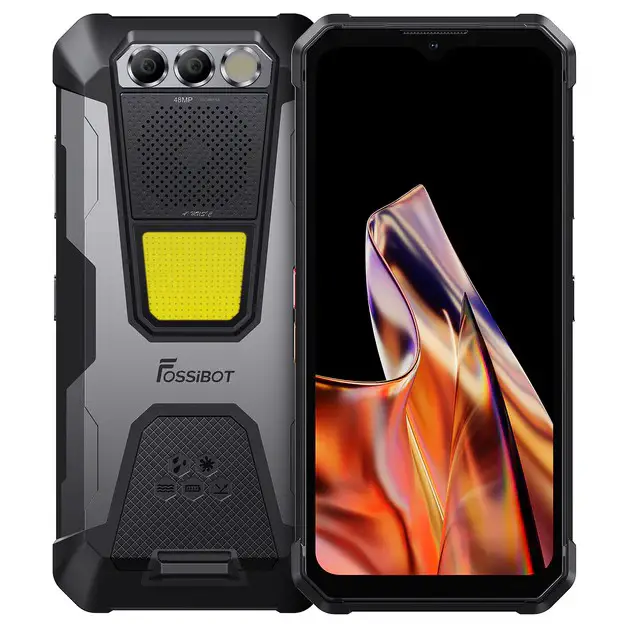

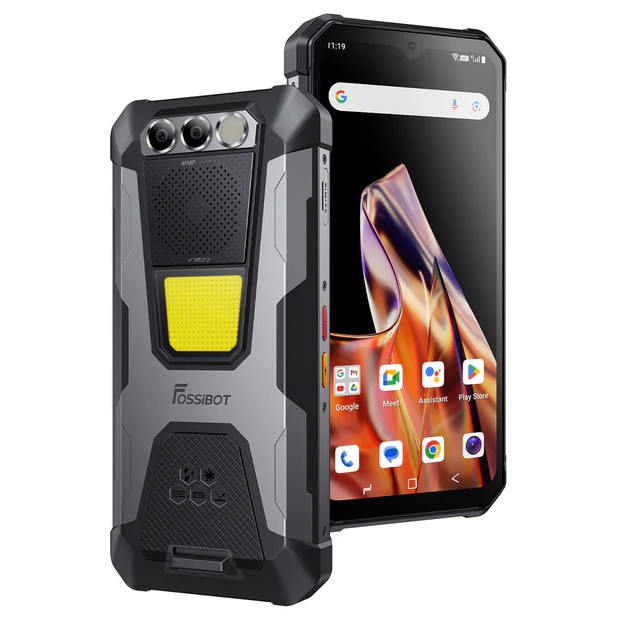
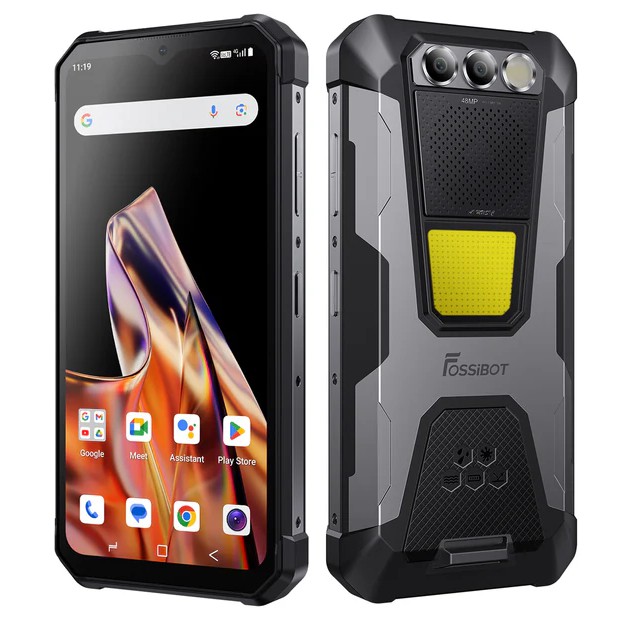
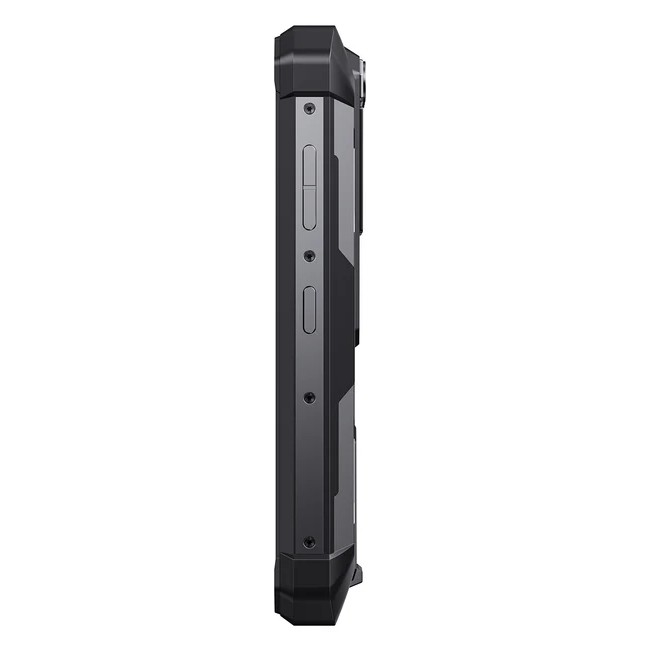
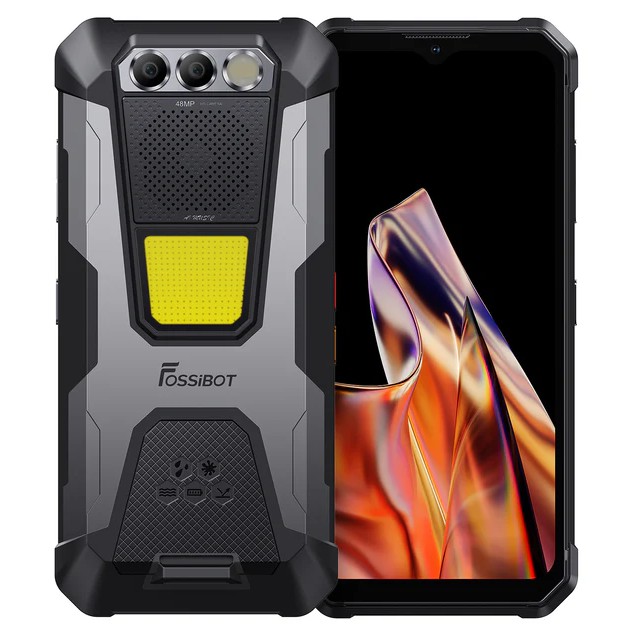
The Fossibot F106 Pro, released in April 2024, builds upon the F102's foundation, offering a more powerful speaker, improved night vision capabilities, and a slightly slimmer design. Nevertheless, the F106 Pro is better considered as a separate device than a successor to the F102 since the hardware seem to be downgraded. Let's explore its specifications:
Network
The F106 Pro maintains the same broad network compatibility as the F102, supporting a wide range of 2G, 3G, and 4G bands. Again, verifying compatibility with your specific carrier is recommended.
Durable & Lighter Build
Like its predecessors, the F106 Pro prioritizes durability with IP68/IP69K dust and water resistance and MIL-STD-810H drop protection. It boasts a slightly slimmer profile compared to the F102, measuring 174.2 x 82.4 x 22.3 mm and weighing 470 grams.
Large Display
The F106 Pro retains the same impressive 6.58-inch TFT LCD touchscreen display with 16 million colors and a 1080 x 2408 pixel resolution as the F102. It offers a 20:9 aspect ratio and a pixel density of 401 PPI for sharp visuals.
Upgraded Software & Powerful Performance
The F106 Pro takes a step forward with the latest Google Android 14 operating system. The Chipset and memory on the other hand seems to be a downgrade since it is powered by the Helio G85 and come with 8GB RAM, instead of the Helio G99 and 12GB RAM on the Fossibot F102 model.
The phone comes with 256GB of UFS storage just like it predecessor, and it offers up to 7GB of virtual RAM expansion. Storage can be also expanded with a microSD card up to 512GB, although this will take up the space for the second SIM card.
Camera System with Night Vision
The F106 Pro's camera system features a downgrade in the main sensor resolution compared to the F102 (48MP OV48B vs 108MP Samsung HM2). However, it retains the 20MP Sony IMX350 night vision sensor for excellent low-light photography. The front-facing camera is also downgraded to a 16MP Sony IMX471 sensor. Both rear and front cameras can record videos in up to 2K resolution at 30fps.
Standard Connectivity & Navigation
Similar to the F102, the F106 Pro offers Bluetooth 5.0 connectivity, WiFi 2.4G-5G, and USB Type-C 2.0 for charging and data transfer. Navigation is aided by a full suite of global navigation satellite systems (A-GPS, GLONASS, BeiDou, Galileo, and QZSS). The phone includes essential sensors like a fingerprint scanner (now side-mounted), accelerometer, proximity sensor, and compass.
Large Battery & Unique Features
The F106 Pro boasts a substantial 12,000mAh Li-Po battery, offering ample power for extended use. It also supports 30W fast charging for quicker replenishment. The F106 Pro comes in a new grey color option. A key highlight is the upgrade to 103dB loudspeakers, promising significantly louder and more powerful audio compared to the F102. The F106 Pro retains the 3W, 3-level adjustable camp light with an impressive 512 Lumen brightness, perfect for illuminating outdoor environments. NFC and HAC support are also present.
While the Fossibot F106 Pro offers some improvements, the core performance may be slightly lower than the F102 due to the different chipset. However, the upgraded speakers, night vision camera, and slightly slimmer design might be attractive features for some users. As always, network compatibility verification is important before purchasing. The full specification of the device are contained in the table below,
| Launch This refers to the date when this device was officially introduced into the market. | Announced 2024, April 11 / Released 2024, April |
| Brand / Model These are key identifiers that indicate the manufacturer or company that produces this smartphone, and the specific model of the phone. | Fossibot / F106 Pro |
| 2G Bands 2G refers to the second generation of cellular technology and includes various frequency bands for basic voice and text communication. | GSM Band 850 / 900 / 1800 / 1900 - SIM 1 and SIM 2 |
| 3G Bands 3G refers to the third generation of cellular technology, encompassing different frequency ranges for faster data speeds, mobile internet, and multimedia capabilities. | 3G Bands 1 / 2 / 4 / 5 / 8 |
| 4G Bands 4G refers to the fourth generation of cellular technology, operating in specific frequency bands to provide significantly faster data speeds, supporting high-definition video streaming and advanced applications. | LTE Bands 1 / 2 / 3 / 4 / 5 / 7 / 8 / 12 / 17 / 18 / 19 / 20 / 25 / 26 / 28A / 28B / 38 / 39 / 40 / 41 / 66 |
| Ruggedity This indicates the device's durability and ability to withstand harsh conditions or impacts. It is a very popular term used with tough or rugged phones. IP68/IP69K are international ratings that measure a smartphone's resistance to dust and water. MIL-STD-810H is a military standard that sets criteria for the environmental and durability testing of electronic devices. It means this device has undergone various tests to demonstrate its resilience in challenging conditions, such as extreme temperatures, humidity, vibration, and shock. |
IP68 / IP69K / MIL-STD-810H - Water / dust resistant / shock resistance |
| Dimensions / Weight: This refers to the physical size and weight of the device, measured in millimeter (mm) and grams (g) respectively. | 174.2 x 82.4 x 22.3 mm / 470 grams |
| SIM SIM stands for "Subscriber Identity Module." It is a small card, typically inserted into a slot in a mobile phone, that contains important information for connecting the device to a mobile network. SIM cards can come in various sizes, including standard SIM, micro SIM, nano SIM, or even electronic (eSIM), depending on the phone's design. | Hybrid Dual SIM (Nano-SIM, dual stand-by) |
| Screen Display refers to the screen or visual interface of the device. It includes details such as screen size, resolution, and technology (e.g., LCD, OLED, AMOLED). | 6.58-inches / TFT LCD touchscreen / 16M colors |
| Resolution Screen Resolution refers to the number of pixels that make up the display screen and is typically expressed as a combination of horizontal and vertical pixel counts (e.g., 1920 x 1080, 2560 x 1440, or 3840 x 2160). The screen resolution determines the level of detail and sharpness of the visual content displayed on the smartphone's screen. Higher resolutions generally result in crisper and more detailed images and text | 1080 x 2408 pixels / 20:9 aspect ratio / 401 PPI |
| Features Camera features encompass various functionalities and capabilities that enhance the device's photography and videography experience. These features can include Optical Image Stabilization (OIS) Panorama, HDR, Ai Mode, Night Mode, Portrait Mode, etc. | Scratch resistant glass (unknown) |
| OS This is the Operating System. It refers to the software platform that runs on the smartphone and manages the device's hardware and software resources. Common smartphone operating systems include Android (developed by Google), iOS (developed by Apple). | Google Android 14 |
| Chipset This refers to the integrated circuit that serves as the device's central processing unit (CPU). It plays a pivotal role in the smartphone's performance, speed, and energy efficiency. |
Mediatek MT6769Z Helio G85 (12nm) - Octa-core (2x2.0 GHz Cortex-A75 & 6x1.8 GHz Cortex-A55) - Mali-G52 MC2 GPU |
| Memory This encompasses two components: storage capacity and RAM (Random Access Memory). Storage capacity, typically measured in gigabytes (GB) or terabytes (TB), dictates how much internal space is available for apps, files, and media storage. RAM, measured in gigabytes (GB), is temporary memory crucial for multitasking and app performance, with more RAM generally leading to smoother operation and faster task-switching capabilities. |
8GB RAM + 256GB ROM (LPDDT4x / UFS) - Expandable RAM: 7GB - SD-card support up to 512GB (uses SIM 2 slot) |
| Main The main camera, also known as the rear camera, is the primary camera on the back of the smartphone. It is typically used for capturing photos and videos in various scenarios and is often the more powerful and versatile camera on the device |
Main: 48MP OV48B, 1/2.25", PDAF, F/1.8 aperture NightVision: 20MP Sony IMX350, 1/2.78", F/1.8, 77° FoV, Night Vision LED light |
| Selfie The selfie camera, also known as the front-facing camera, is the camera on the front of the smartphone, primarily used for capturing selfies and video calls | 16MP Sony IMX471, 1/3.1". F/2.45 aperture, 73.7° FoV | No LED flash |
| Features Camera features encompass various functionalities and capabilities that enhance the device's photography and videography experience. These features can include Optical Image Stabilization (OIS) Panorama, HDR, Ai Mode, Night Mode, Portrait Mode, etc. | 2K/1080p@30fps video recording / LED Flash |
| Connectivity This encompasses the device's ability to connect and communicate with other devices and networks. It includes features such as cellular connectivity, Wi-Fi, Bluetooth, NFC (Near Field Communication), and USB connectivity options. | Bluetooth 5.0 A2DP / WiFi 2.4G-5G / USB Type-C 2.0 |
| Navigation Navigation refers to the device's ability to determine and display location information and provide directions to users. This functionality is usually powered by Global Positioning System (GPS) technology. | A-GPS, GLONASS, BeiDou, Galileo, QZSS |
| Sensors This refers to the various built-in sensors that enable the device to gather information from its environment and interactions. Common sensors found in rugged smartphones may include fingerprint sensor, light sensor, barometer sensor among others. | Fingerprint scanner (side-mounted), accelerometer, proximity, compass |
| Battery This section refers to the device's power source and its related specifications. This typically includes details such as the battery capacity, measured in milliampere-hours (mAh) or watt-hours (Wh), and it charging details. | Li-Po 12,000mAh, non-removable with 30W fast charger |
| Others This is a catch-all category that includes various additional features, specifications, or capabilities that don't fall under the major categories like display, camera, memory, or connectivity. |
Grey color 103dB loud speakers Dedicated 3W (3-level) camp light with 512 Lumen NFC and HAC supported |
These specifications were entered manually, hence we CANNOT guarantee 100% accuracy. Also, that your device is listed on this website DOES NOT call for reckless usage! It is crucial to exercise due diligence, as we cannot be held responsible for any damage to your device due to overconfidence in it built quality.
Leave a Reply